يمكن لحدود الإدارات والعمل اللامركزي أن يترك فريقك مفككاً وفي حالة من الفوضى. وتتجلى هذه التحديات بشكل أكبر في فرق العمل عن بُعد والفرق المختلطة، وغالباً ما يكون من الواضح جداً أن مكان العمل يفتقر إلى التآزر التعاوني.
لحسن الحظ، فإن أفضل ممارسات التعاون متعدد الوظائف توفر طوق نجاة للفرق المنعزلة. فهي تعمل من خلال تيسير التواصل والتعاون للتنسيق بين الأقسام متعددة التخصصات. يتناغم التسويق مع المبيعات، وتنسجم الموارد البشرية مع تكنولوجيا المعلومات، وتنهار الصوامع، ويحدث السحر! 🪄
سواء كنت تتصارع مع الأولويات المتضاربة، أو مع عوائق التواصل، أو
مقاومة التغيير
فهذا الدليل مخصص لك. سنستكشف كيف يهدف التعاون متعدد الوظائف إلى كسر هذه الحواجز وتعزيز العمل الجماعي والتواصل بين الأقران من مختلف الأقسام.

ما هو التعاون متعدد الوظائف، ولماذا تحتاجه الفرق؟
يمثل التعاون متعدد الوظائف ترياقًا قويًا مضادًا ل "عقلية الصومعة" المنتشرة التي تميل إلى أن تصيب المؤسسات متعددة الأقسام. في فرق العمل المنعزلة، قد يمتنع الموظفون عن مشاركة المعلومات مع زملائهم من قسم آخر، مما يقوض الكفاءة ويعيق الابتكار.
في المعركة ضد المشاكل التي تعيق التقدم، مثل الصوامع وثقافات العمل المنعزلة، يبرز التعاون متعدد الوظائف كسلاح سري. يعمل هذا النهج الاستباقي على تغذية بيئة تقدّر مشاركة المعرفة، وتحفيز الفرق والمجالات الوظيفية الأخرى على التعاون في التعامل مع الأهداف والتحديات المشتركة.
يمكن أن يحدث التعاون بشكل عضوي، مثل طلب المصمم المساعدة من قسم المبيعات لفهم جمهوره بشكل أفضل. كما يمكن أن يتم التخطيط له منذ البداية، حيث يتم تنظيم المشروع بأكمله بحيث يشمل التعاون بين مختلف الوظائف. 🧑🤝🧑
الأمر أشبه بفتح الأبواب التي تفصل بين مختلف الأقسام، مما يسمح بتلاقي المهارات ووجهات النظر، وفي نهاية المطاف تعزيز الابتكار وتحسين عملية اتخاذ القرار. لا يعزز التعاون متعدد الوظائف الشعور بالوحدة فحسب، بل يحول مكان العمل إلى بيئة أكثر جاذبية وإشباعًا. الفكرة الأساسية: _الجهد المشترك يفوق مجموع المساهمات الفردية!
8 أسباب لتطبيق التعاون متعدد الوظائف في شركتك (مع نصائح)
وفقًا لـ مسح أجرته شركة ديلويت فإن 83% من الشركات المتقدمة رقميًا تستفيد من قوة فرق متعددة الوظائف للبقاء "ذكيًا" و"الحفاظ على الميزة التنافسية" وبينما تقدر الشركات في مراحلها الأولى هذا النوع من التعاون، إلا أنها غالبًا ما تكون غير قادرة على الاستفادة من الموارد المناسبة لتحقيق ذلك.
دعنا نتناول فيما يلي أهم ثماني فوائد جديرة بالملاحظة للتعاون بين فرق العمل متعددة الوظائف. سنستكشف أيضًا بعض أدوات إدارة المشاريع في انقر فوق ، أداة تعاون وإدارة العمل الأعلى تصنيفًا والتي يمكن أن تساعد الفرق متعددة التخصصات على تهيئة نفسها لتحقيق النجاح في المستقبل. 🛸
1. تعزيز الابتكار والإبداع في العمل
يتمحور التعاون متعدد الوظائف حول الاستفادة من التناغم بين تعاون الفريق لاستكشاف الأفكار الرائدة التي قد يتم تجاهلها في الأقسام المنعزلة.
ومن الأمثلة الرائعة على ذلك كيفية اجتماع فرق تطوير المنتجات وفرق المبيعات للعمل على ميزات تطبيق جديد. هذا الأخير أكثر إدراكًا لـ نقاط الألم لدى العميل المستهدف بينما يمتلك فريق المنتج مهارات الترميز لتنفيذ ميزات جديدة مبتكرة. ويساهم الفريقان اللذان يتشاركان وجهات نظرهما في نهاية المطاف في تطوير منتج وظيفي من المرجح أن يكسب العملاء.
إذا كنت ترغب في أن تجتمع المواهب المتنوعة داخل فريقك متعدد الوظائف لابتكار شيء أعظم، استفد من أدوات التعاون الرقمي المتعددة في العصر الجديد على ClickUp. 🌻
خذ ClickUp Whiteboards أو الخرائط الذهنية على سبيل المثال - فهي بمثابة جسر يربط بين العقول والأفكار، ويحول الابتكار إلى عمل!
يمكنك الحصول على لوحات رقمية لا حصر لها حيث يمكن للفرق متعددة الوظائف التعاون من أجل العصف الذهني وطرح أفكار جديدة ومناقشة جدوى تنفيذها - في الوقت الفعلي! سواء كانت التخطيط السريع أو صياغة خطط التسويق، أو تعزيز العمل الجماعي عبر فرق العمل عن بُعد، تضع المنصة الجميع في نفس الغرفة، إذا جاز التعبير، مما يتيح لهم الابتكار!

تعاون مع العملاء أو الفرق الداخلية بفعالية أكبر باستخدام السبورات البيضاء الافتراضية لتحفيز الابتكار
هل تريد مشاركة أفكارك المبتكرة عبر المنصات؟ سلس تكامل ClickUp مع الأدوات والخدمات الخارجية مثل جوجل درايف و سلاك يعمل على تبسيط البيانات المبعثرة ويمنع الانعزال.
2. حل أسرع للمشاكل مع عمليات أكثر شفافية
إذا سبق لك أن انغمست في تجميع الألغاز، فمن المحتمل أنك واجهت تلك اللحظة المحبطة عندما لا تستطيع تحديد القطعة المراوغة اللازمة لتكوين الصورة الكاملة. هذا هو الحال في كثير من الأحيان مع حل المشاكل داخل الأقسام المغلقة بسبب سوء توثيق العمليات أو مراقبتها - من الصعب تحديد ما هو الخطأ.
ولكن مع وجود فريق مترابط بشكل جيد يتبع عمليات شفافة ، فمن الأسهل ملاحظة ما لا يعمل بالضبط كما ينبغي، مما يجعلك تصل إلى لحظة "آها-ها" بشكل أسرع. 🧩

قم بتقسيم المشاريع المعقدة إلى مهام يمكن إدارتها والإشراف على جميع أعمالك باستخدام الحالات المخصصة والحقول المخصصة والمزيد باستخدام هيكل تقسيم العمل في ClickUp
هل تتطلع إلى إنشاء عمليات عمل شفافة بين الأقسام؟ استفد من إدارة المهام داخل ClickUp. كسر تدفقات العمل الكبيرة إلى مهام يمكن إدارتها، وإنشاء مهام فرعية، وتتبع التقدم المحرز، مما يتيح سرعة اكتشاف المشكلات وحلها.
إذا لاحظت أي مشكلة، قم بتخصيص معلمات حل المشكلات باستخدام الحقول المخصصة . على سبيل المثال، يمكنك تصنيفها وترميزها بالألوان مستويات الأولوية مما يسمح لك بالتركيز على المشاكل الأكثر أهمية أولاً. بالإضافة إلى ذلك، إضافة تواريخ الاستحقاق و التذكيرات يضمن حل المشكلات في الوقت المناسب عبر الأقسام.
3. زيادة كفاءة المهام
وفقًا لـ دراسة لجامعة ستانفورد أن فرق العمل التعاونية المنسقة جيدًا والمنسقة جيدًا أكثر كفاءة بنسبة 50% في إنجاز المهام من العمال المنفردين. لماذا؟
حسنًا، أفضل الفرق متعددة الوظائف لا تضيع الوقت في تكرار الجهود، حيث أن سير العمل والمسؤوليات واضحة. هناك أيضًا معرفة مشتركة حول إجراءات التشغيل القياسية والوقت المقدر المطلوب لكل مهمة، وكل ذلك يساهم في سير عمل فريقك كالساعة!
بصفتك أداة إدارة المهام ، تساعدك ClickUp على جعل أي مساحة عمل أكثر كفاءة وتنظيمًا ومصممة خصيصًا لتلبية احتياجات الإدارات.
مع تتبع وقت ClickUp يمكنك توقيت أي عملية، وإضافة ملاحظات للرجوع إليها في المستقبل، والتأكد من أن الجميع على نفس الصفحة. تمامًا مثل الآلة التي يتم تشغيلها بشكل جيد، فهي تقلل من وقت التعطل وتضمن استخدام الموارد على النحو الأمثل. ⏳
![]()
إنشاء جداول زمنية ومراقبة الوقت الذي يتم تتبعه عبر الأقسام في ClickUp
إنشاء مستودع للعمليات المشتركة والوثائق المشتركة على مستندات ClickUp واستمتع بتوصيل أسرع، وحلقات التغذية الراجعة والتحديثات. بالإضافة إلى قوة أتمتة ClickUp في متناول يدك يعني أنه يمكنك توديع المهام المتكررة والتركيز بدلاً من ذلك على دفع الأهداف المشتركة.
ستحب خاصية اكتشاف التعاون المباشر في Clickup إذا كنت تتطلع إلى منع العمل الزائد عن الحاجة. فهي تتيح لك معرفة ما إذا كان أحد زملائك في الفريق يعمل على نفس المهمة أو المستند معك. يمكنك متابعة التعاون مع مؤشرات متعددة أو تصحيح الوضع إذا كان هناك خطأ.
4. تعزيز التواصل ومشاركة الموظفين
عندما يتعاون الأشخاص من مختلف الأقسام، يكون الأمر أشبه بنسج راية التعاون. 🕊️ التواصل الجماعي هو شريان الحياة لأي فريق متعدد الوظائف، حيث يشكل ثقافته ويدفع عجلة النمو. غالبًا ما ينطوي مفتاح تحقيق هذه الميزة على التواصل الداخلي أو الاجتماعات عبر الإنترنت وجلسات العصف الذهني لمناقشة العمل الحالي أو المستقبلي.
تعتمد معظم الفرق متعددة التخصصات على المراسلة و أدوات التعاون لتسهيل التدفق السلس للمعلومات بين أعضاء الفريق.
ClickUp هي وسيلة الاتصال المزامنة وغير المزامنة. استخدم تعليقات ClickUp داخل المستندات للسماح بالتعليقات والمناقشات غير المتزامنة. يمكنك أيضًا تبسيط الموافقات على سير العمل باستخدام ميزة التدقيق مركزية الملاحظات وتسريع عملية تسليم المستندات والصور ومقاطع الفيديو.
ويصبح الأمر أفضل عندما تدمج ClickUp مع أدوات مثل تكبير , فرق مايكروسوفت و Google Chat و Discord، مما يجعل من السهل التواصل مع فرقك عبر المنصات!
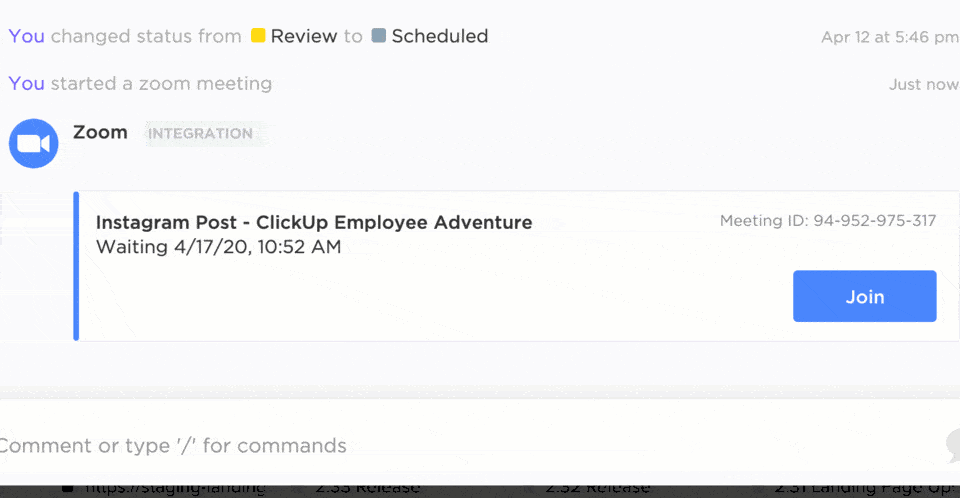
ابدأ الاجتماعات وانضم إليها مباشرةً من مهامك باستخدام تكامل Zoom الخاص ب ClickUp
علاوة على ذلك، فإن ميزة ClickUp عرض الدردشة , المعالم و يذكر تعزز أيضًا مشاركة الموظفين بشكل عام. إنها مثل التربيت على كتف شخص ما في مكتب مزدحم، مما يضمن أنه جزء من المحادثة!
5. اتخاذ القرارات الشاملة
قد يكون اتخاذ القرارات، خاصة تلك التي تعتمد على وجهات نظر الفريق المتعددة، أمرًا صعبًا. ومع ذلك، في هذه اللحظات بالذات يتألق حقًا القول المأثور "رأسان أفضل من رأس واحد".
من خلال التعاون بين أعضاء الفريق الواحد، يصبح كل فرد قوة من الحكمة الجماعية، مما يجعل أفضل نتيجة ممكنة أكثر قابلية للتحقيق. 🙌
ومع ذلك، يجب أن تكون القرارات المستنيرة مدعومة بالبيانات، وهنا يأتي دور ClickUp Dashboards تأتي لتعزيز ممارسات اتخاذ القرار داخل فريقك. تجعل لوحات المعلومات بيانات الفريق ومقاييسه متاحة بشكل مرئي. مع ثروة من التقارير والأدوات، يكتسب قائد الفريق رؤى أعمق في أي مشروع أو جانب من جوانب الإنتاجية، مما يجعل حل المشكلات واتخاذ القرارات أمرًا سهلاً.
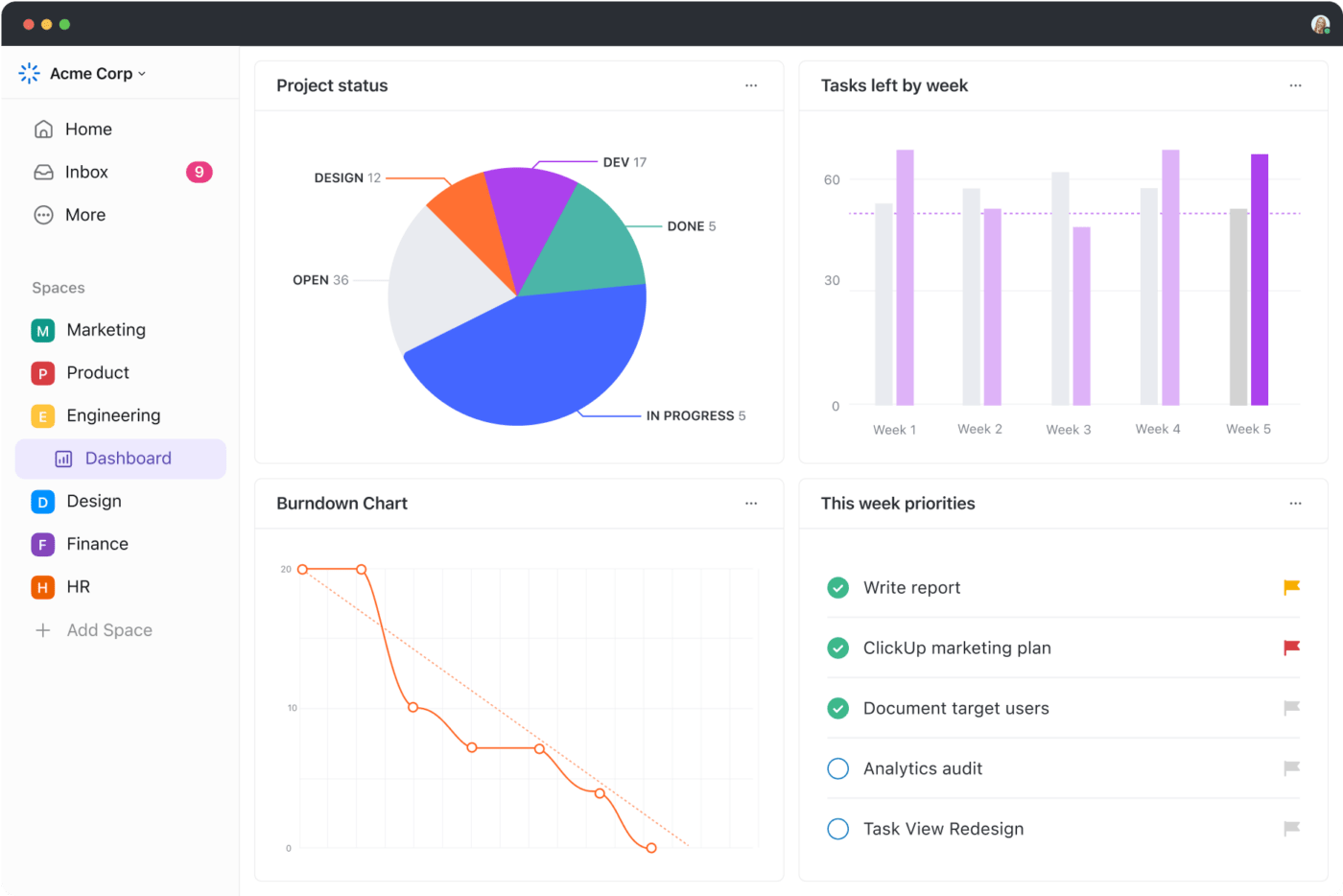
توفر لوحات المعلومات في ClickUp لمديري المشاريع الرشيقة عرضًا سريعًا للمهام والأولويات المتبقية للفريق خلال الأسبوع بالإضافة إلى مخططات تفصيلية للإنجاز والتراجع
يمكنك أيضًا الاستفادة من ClickUp أكثر من 15 مشاهدة للتعمق في عمليات الإدارات لاتخاذ القرارات عالية المخاطر. على سبيل المثال، فإن عرض القائمة يساعدك على الفرز والتصفية من خلال حقول البيانات الضخمة، بينما يساعدك لوحة كانبان و التقويم وجهات النظر محبوبة من قبل مديري المشاريع الرشيقة وقادة الفرق الذين يتخذون القرارات في ظل المواعيد النهائية الضيقة.
6. تخصيص أفضل للموارد على مستوى الفريق
التعاون المتبادل في العمل يدور حول تحسين الموارد. كيف؟ دعونا نتخيل هذا الموقف الغريب بين زميلين في العمل، بوب من قسم تكنولوجيا المعلومات وأليس من قسم التصميم، اللذين يشعران بالقلق بشأن أعباء العمل الخاصة بهما.
مكتب بوب مكدس بالعمل، ويشعر أن قسمه بحاجة إلى المزيد من المتدربين. تشعر أليس أن قسمها لديه عدد كبير جدًا من المتدربين وموارد التدريب غير كافية، مما يجعلهم يعبثون بأصابعهم. إنه مثال كلاسيكي على سوء تخصيص الموارد في فريق متعدد الأقسام.
في هذه الحالة، يمكن للتعاون متعدد الوظائف أن يعمل كوسيط حكيم، ويصحح الوضع من خلال تخصيص الموارد البشرية بشكل عادل. لذا، لا مزيد من توجيه أصابع الاتهام بين بوب وأليس - يسود السلام، وأخيرًا أصبحت استراحات القهوة بينهما بدون دراما! 😁
يكمن جمال التخصيص الفعال للموارد البشرية في أنه لا يتعلق فقط بتوازن عبء العمل ولكن الصحة النفسية والإنتاجية في جميع الأقسام. فهو يساعد في الوفاء بالمواعيد النهائية، والحد من الإرهاق، وتحسين الرضا الوظيفي، مما يخلق وضعًا مربحًا لكل من الفريق والمؤسسة. ✅
هل تحتاج إلى مساعدة في تخصيص الموارد؟ إن عرض الفريق في ClickUp أشبه برؤية شاملة لعبء العمل في فريقك. فهو يوفر تمثيلاً مرئياً واضحاً لمن يقوم بماذا ومتى، ومع القدرة على سحب وإسقاط المهام بين الموارد المختلفة، يصبح من السهل جداً موازنة أعباء العمل وتخصيص المهام بناءً على السعة.
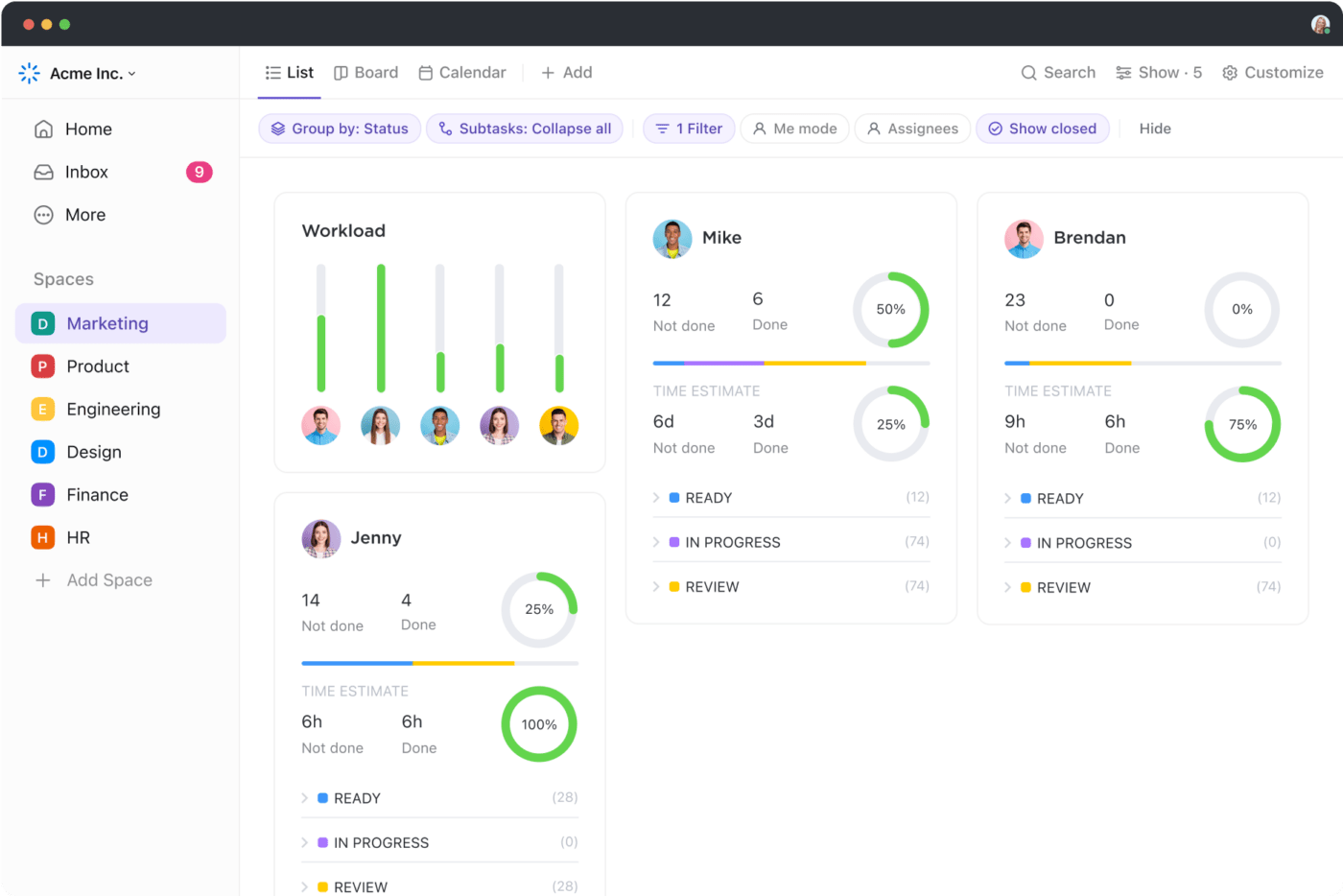
يوفر ClickUp عرضًا مبسطًا لرؤية عبء عمل فريقك بأكمله أو عبء عمل فرد ما للحفاظ على سير العمل
والآن، إذا كنت ترغب في تعديل جدولك الزمني أو إعادة تنظيم تبعيات المهام داخل الأقسام، فإن انقر فوق عرض مخطط جانت البياني يتيح لك القيام بذلك ببضع نقرات، مما يجعل سير عملك مرنًا قدر الإمكان!
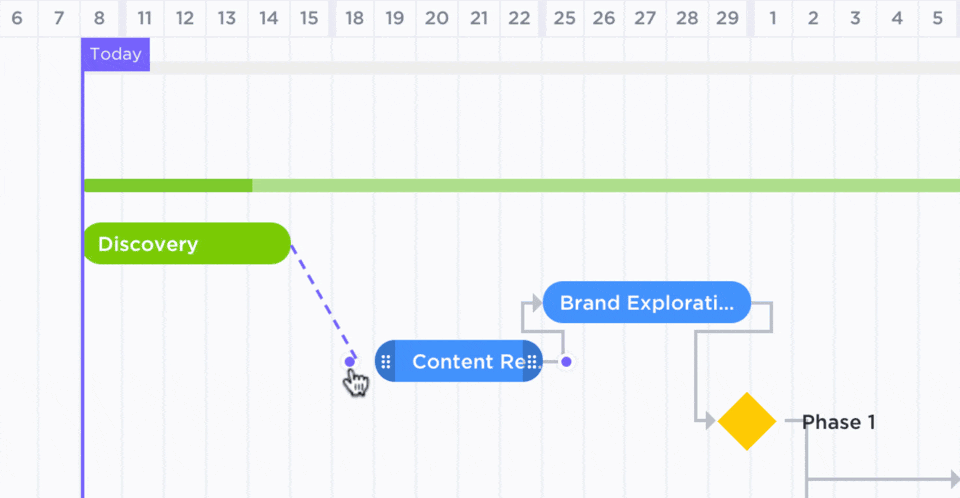
إظهار العلاقات بين المهام داخل الأقسام في طريقة عرض مخطط جانت في ClickUp
7. تعزيز التعلم والتطوير
في الفصل الدراسي التعاوني متعدد الوظائف، يصبح الموظفون طلابًا ومعلمين في آنٍ واحد. إنها بيئة تتدفق فيها المعرفة بحرية بين الزملاء من مختلف الأقسام، مما يسمح لهم باكتساب مهارات جديدة وتبادل الأفكار والخبرات. وهذا يساعد الفرق في نهاية المطاف على الحفاظ على مرونة واتحاد الفرق في خضم تحديات السوق. 🧑🎓
8. مساءلة وثقة أقوى
غالبًا ما يلعب الفريق المنهار لعبة إلقاء اللوم عندما تسوء الأمور، لكن الفرق السليمة متعددة الوظائف تكون في وضع أفضل لإرساء المساءلة والتعلم بشكل جماعي من الإخفاقات.
التعاون متعدد الوظائف يعزز الشعور بالملكية، مما يضمن:
- يشعر الجميع بالمسؤولية عن مجموعة معينة من المهام
- يعرف كل عضو أنه جزء حيوي من اللغز
- يتم حل النزاعات بين الفرق بشكل أسرع بسبب الإحساس المشترك بالمسؤولية
العمل معًا في مشاريع متعددة الوظائف يبني علاقات أقوى وثقة أكبر بين أعضاء الفريق، مما يعزز من الإيجابية و ثقافة العمل التعاوني .
أفضل الممارسات للتعاون الفعال متعدد الوظائف ## أفضل الممارسات للتعاون الفعال متعدد الوظائف
للاستفادة من الإمكانات الكاملة للتعاون متعدد الوظائف في مؤسستك، اعتمد أفضل الممارسات التالية:
- التواصل الواضح بين فرق العمل: أنشئ قنوات اتصال مفتوحة وشفافة لضمان تدفق المعلومات بحرية بين الفرق
- الأهداف المشتركة: تحديد الأهداف المشتركة وتوصيلها بوضوح لضمان أن الجميع يعمل على تحقيق نفس النتيجة
- الأدوار والمسؤوليات: حدد أدوار ومسؤوليات كل عضو من أعضاء الفريق لتجنب الالتباس وازدواجية الجهود
- الاجتماعات الدورية: جدولة اجتماعات منتظمة للفريق متعدد الوظائف لمناقشة التقدم المحرز، ومعالجة التحديات، ومشاركة التحديثات
- احترام وجهات النظر المتنوعة: احتضان وتقدير وجهات النظر والخبرات المتنوعة التي يجلبها كل فريق، وتعزيز ثقافة الاحترام والشمول
- الأدوات التعاونية: التنفيذالأدوات التعاونية والتكنولوجيا لتسهيل مشاركة المعلومات وإدارة الفريق
- آلية التغذية المرتدة: إنشاء مساحة آمنة لأعضاء الفريق لمشاركة أفكارهم واهتماماتهم، مما يضمن التحسين المستمر الخالي من التحيز
- حل النزاعات: حل النزاعات: تطوير عملية لتسوية النزاعات أو الخلافات التي قد تنشأ أثناء التعاون بين الإدارات
- المساءلة: إنشاء تسلسل هرمي واضح داخل الأقسام بحيث يمكن مساءلة كل عضو عن مساهماته والتزاماته تجاه الجهد التعاوني
- الاحتفال بالإنجازات: التعرف على الإنجازات والاحتفال بها وتنظيمهاأنشطة بناء الفريق لرفع الروح المعنوية والتحفيز
4 نماذج للتعاون الفعال متعدد الوظائف ## 4 نماذج للتعاون الفعال متعدد الوظائف
فيما يلي أربعة نماذج قوالب النقر فوق مصممة لتبسيط وتعزيز التعاون بين فرق العمل المتنوعة، مما يضمن نجاح مشاريعك نجاحًا باهرًا. 🥳
1. قالب مشروع ClickUp متعدد الوظائف
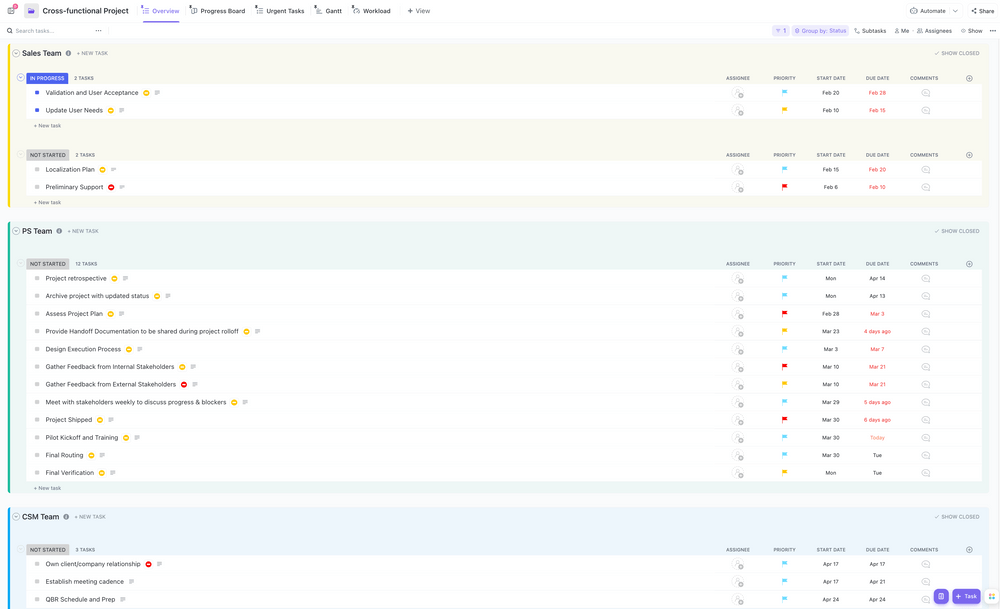
ClickUp قالب المشروع متعدد الوظائف هو شريكك الأساسي لضمان التعاون المنظم بين فرق العمل
هل تحتاج إلى اختصار لتكييف أفضل ممارسات التعاون متعدد الوظائف؟ إن قالب مشروع ClickUp متعدد الوظائف يمكن أن يكون حليف فريقك!
لا مزيد من المستندات المبعثرة أو الارتباك - في قالب المجلد هذا، ستجد مساحة مخصصة لكل قسم مشارك في مشروعك، مثل
- فريق إدارة البرنامج
- فريق خدمة العملاء
- فريق المبيعات
كل مساحة لها قائمة مهام خاصة بها، مما يسهل على المستخدمين التركيز على مسؤوليات الأقسام والمسؤوليات العامة. ولكن السحر الحقيقي يحدث مع عرض جانت . فهو يوفر خريطة طريق مرئية للجدول الزمني لمشروعك، مما يساعدك على اكتشاف المشكلات والعقبات المحتملة.
ضمن طريقة عرض عبء العمل، سيكون لديك عرض واضح لـ الحقول المخصصة مثل الميزانية والميزانية المتبقية ومعدلات الأداء الرئيسية للشركة والقسم، مما يتيح لك إدارة مهامك ومواردك بكفاءة.
تعمل المهام العاجلة كحارسك اليقظ، حيث تحميك من التقصير في المهام، بينما تقدم لك المشاهدة العامة عرضًا بانوراميًا لمشهد مشروعك. باستخدام لوحة التقدم، يمكنك توضيح رحلة مشروعك في شكل بطاقات على لوحة.
وبالإضافة إلى طرق العرض، يضم القالب مستندات المشروع، بما في ذلك ميثاق البرنامج لتوضيح الأهداف وتحديد أصحاب المصلحة و محاضر الاجتماعات لتسجيل جداول أعمال الاجتماعات والنتائج الرئيسية.
2. قالب مشروع ClickUp متعدد الوظائف حسب الأقسام
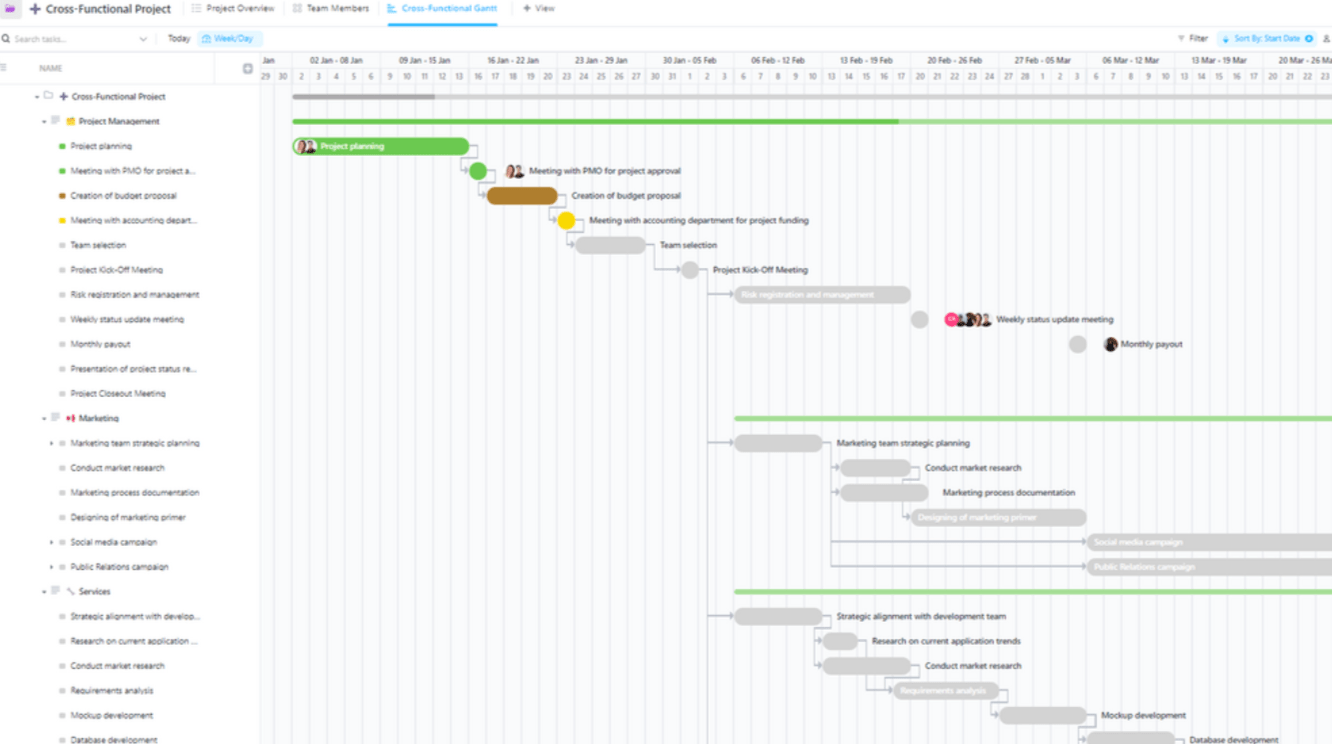
يحافظ هذا القالب على الترتيب، ويضمن وضوح المهام، ويراقب التقدم المحرز بفعالية
فكر في قالب مشروع ClickUp متعدد الوظائف حسب الأقسام كمساعد شخصي لفريقك. فهو يحافظ على كل شيء منظم وقابل للتتبع حسب الأقسام.
يحصل كل قسم تضيفه على مساحة مخصصة للمهام. على سبيل المثال، ضمن علامة التبويب "التسويق"، يمكنك إضافة المهام المتعلقة بالحملات الإعلانية أو استراتيجيات وسائل التواصل الاجتماعي.
يكمن جمال هذا القالب في أنه يقدم طرق عرض مختلفة لكل قسم. يمكنك عرض المهام بصيغة القائمة، أو رؤيتها موضوعة على لوحة، أو الاطلاع على ما يعمل عليه الجميع باستخدام طريقة عرض الصندوق. 👀
القالب مثالي لـ إعداد تبعيات المهام بين الأقسام، مما يقلل بشكل كبير من الوقت اللازم لتخطيط سير العمل المعقد. استخدم عرض جانت متعدد الوظائف لتصور هذه المهام على جدول زمني.
تضيف الحقول المخصصة الافتراضية مزيدًا من العمق إلى عمليات المراقبة الخاصة بك، مما يسمح لك بتقييم الأداء، وتعيين الأدوار، وتتبع التقدم المحرز، وتبديل الموارد.
3. انقر فوق قالب خطة المشروع متعددة الوظائف

ربط خطة مشروعك بين فرق العمل وإعطاء أصحاب المصلحة إرشادات مفصلة لتحقيق النجاح
يمكن أن يكون التنقل في الشبكة المعقدة للعمل الجماعي متعدد الوظائف أكثر صعوبة عند التعامل مع مشاريع متعددة. وهنا يأتي دور قالب خطة المشروع متعدد الوظائف من ClickUp يتدخل كنجم إرشادي لك، ويبسط تخطيط وإدارة المشاريع المعقدة.
يكشف هذا القالب عن هيكل تسليم سلس داخل ClickUp مباشرةً، ويقدم مجموعة من الميزات وطرق العرض المصممة خصيصًا لتحقيق الكفاءة والتنظيم. 🌟
ستجد طريقة عرض قائمة منظمة بشكل جيد ترتب التسليمات الوظيفية، وتجمع الأنشطة حسب الفريق والحالة الخاصة بكل منها. ثم هناك عرض لوحة التقدم، وهي طريقة رائعة لتتبع الأنشطة خلال مراحل المشروع. وبالطبع، هناك طريقة عرض Gantt view التي تكشف النقاب عن الجدول الزمني لمشروعك، وتوضح التبعيات بوضوح تام. ولإضافة طبقة إضافية من الرؤية، تكشف طريقة عرض الخط الزمني للمشروع عن مدد الأنشطة.
قم بتعيين أعضاء الفريق وإشراك أصحاب المصلحة وتعيين مراقبي المشروع وتعيين الموافقين لمراحل سير العمل المختلفة دون عناء. يؤدي ذلك إلى التخلص من الارتباك بين أعضاء الفريق ويوفر نظرة عامة مخصصة للمشروع لبدء كل مهمة وإنهائها.
4. قالب مستندات فريق ClickUp Team Docs
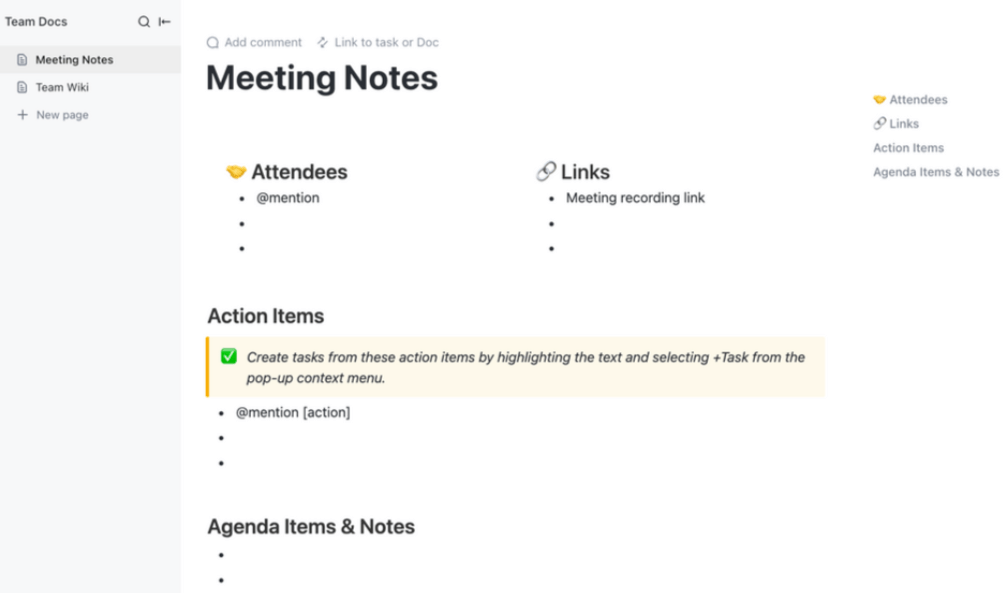
هذا القالب هو رفيقك الأمثل لتعاون الفريق بكفاءة وإدارة المعرفة
إن قالب مستندات فريق ClickUp عبارة عن دمج ملاحظات الاجتماع وويكي الفريق، مما يؤدي إلى إنشاء مركز معلومات قوي في متناول يدك. 👐
مكوِّن ملاحظات الاجتماع يشبه الشفرة الحادة التي تخترق الثرثرة لالتقاط جوهر مناقشاتك. فهو يسرد الحاضرين بدقة، ويوفر روابط مهمة (مثل تسجيل الاجتماع)، ويحدد عناصر العمل المسندة إلى الأفراد، ويضع بنود جدول الأعمال مع الملاحظات المقابلة لها.
يحتوي هذا القالب أيضًا على ويكي فريق شامل ، وهو مركز مركزي يمكنك من خلاله الوصول بسهولة إلى أسماء زملائك في الفريق وفهم أدوارهم داخل المجموعة.
يعد هذا القالب الهجين معًا أداتك المثلى لإبقاء فريقك على اطلاع وتنظيم وجاهزية للعمل!
احتضان التعاون متعدد الوظائف باستخدام ClickUp
التعاون متعدد الوظائف هو أحد تلك الأسلحة المتاحة على نطاق واسع، ولكن القليل من الفرق فقط هي التي تستطيع استخدامه بمهارة. لا يزال العديد من المديرين غير متأكدين من كيفية فرض المساءلة المشتركة - بل ويخشون ذلك!
لم تُبنَ روما في يوم واحد، ولكن مع اتباع نهج مخصص للتعاون، يمكنك البدء في بناء إمبراطوريتك للابتكار اليوم من خلال تسخير قوة ClickUp. 🏰 اشترك للحصول على حساب مجاني وتحرر من قيود تدفقات العمل التقليدية المنعزلة!

